No it’s not the latest release on Jack White’s Third Man label but the true story of how….”In 50s Soviet Union, western records such as Rock Around the Clock and Boogie-Woogie Bugle Boy were banned. But intrepid music lovers found a way to defy the authorities by making bootleg pressings on discarded x-rays”
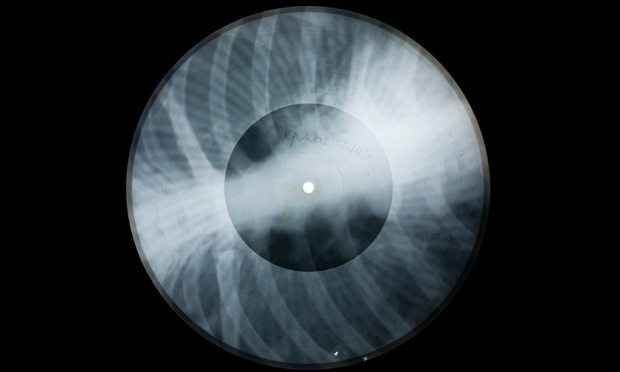
In 1952, Morris Levy – who conducted the day-to-day running of Charlie Parker’s Birdland – decided the New York club needed a sonic calling card, a theme tune ambiguous enough to sound like a love song, but that could run out into the world and trumpet the low-lit glamour of a venue frequented by Judy Garland, Frank Sinatra and Marlene Dietrich. Sixty-three years later, the measure of its success is trilling out of the speakers, via Leningrad, at a Bloomsbury gallery space. Ella Fitzgerald’s Lullaby of Birdland sounds both utterly familiar and yet distant and ghostly – as if heard from across a street being pummelled by torrential rain. Cast your eyes on the source of the music and the effect is only compounded. On the turntable is an x-ray of a human ribcage, on to which is etched the grooves containing Fitzgerald’s 1954 recording.
The X-Ray Audio exhibition at The Horse Hospital in London is the result of an obsession nurtured by Stephen Coates of antiquarian art-poppers the Real Tuesday Weld, which began eight years ago after a chance find at a market stall in St Petersburg. “We had arrived to play some shows,” recalls the rangy frontman between sips of coffee. “I went for a wander in the flea market and I looked at a stall and thought: ‘Is that a record or an x-ray?’” The response from the smallholder was dismissive.” Coates had a chaperone with him, but he wasn’t able to shed any light. Over the next few days, Coates found that he had stumbled upon the postwar Soviet phenomenon of “bone music” (roentgenizdat) – bootleg recordings of music pressed on to discarded x-rays that had been banned in the USSR, lest they promote insurrectionary tendencies in listeners.
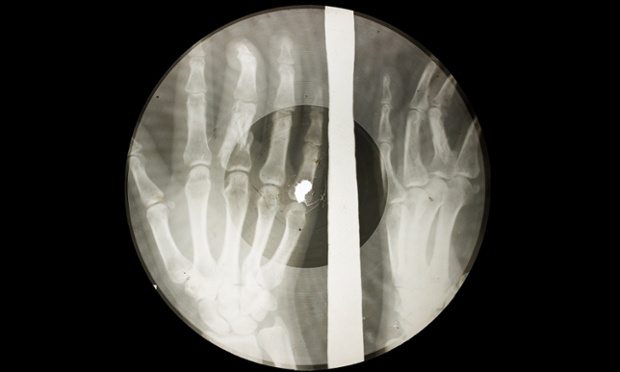
Perhaps the authorities had a point. If the relatively tame jump-jive of Bill Haley & the Comets’ Rock Around the Clock had British teenagers ripping seats out of cinemas in frenzied excitement, one has to wonder what it would have done to young Russians. For teenagers who didn’t much fancy joining the Leninist youth brigades of the Komsomol, the lure of the stilyagi – a hipper subculture that embraced all things jazz, rock’n’roll and Hollywood – must have seemed irresistibly exotic. Certainly appealing enough to send them along to self-styled “culture traders” such as Rudy Fuchs, an engineering student who was so keen to get involved with western music that he regularly gave blood in exchange for cash so that he could save up for a recording lathe. Blood money in exchange for bone music.
Although Coates had already landed on his feet by visiting St Petersburg, where records from overseas would enter the USSR through the port and be used as masters to copy music from, he was told that he would need to meet Fuchs if he wanted to get a handle on the growth of bone music in the 1950s. When he was finally granted an audience with Fuchs, he found a frail octogenarian in a brutalist apartment block surrounded by archaic studio equipment. “Back in the late 50s, Rock Around the Clock was the track that got Rudy fired up to distribute these records to other people – that and Boogie-Woogie Bugle Boy, which was a revelation.”
There was also the noted St Petersburg eccentric, referred to by locals as “the Beatles guy”. For the past five decades, Nikolay Vasin’s life has been spent honouring and celebrating the epiphanic moment he first heard the Beatles on a bone recording. “He showed me his family album,” recalls Coates, “and it was filled with pictures of John, Paul, George and Ringo – mostly John, it has to be said. He also told me that John wasn’t dead, but had made 34 albums since he secretly moved to northern Italy in 1980.” Has he heard any of those albums? “Um, yes! It sounded like John Lennon, albeit with a slight Japanese tinge.”
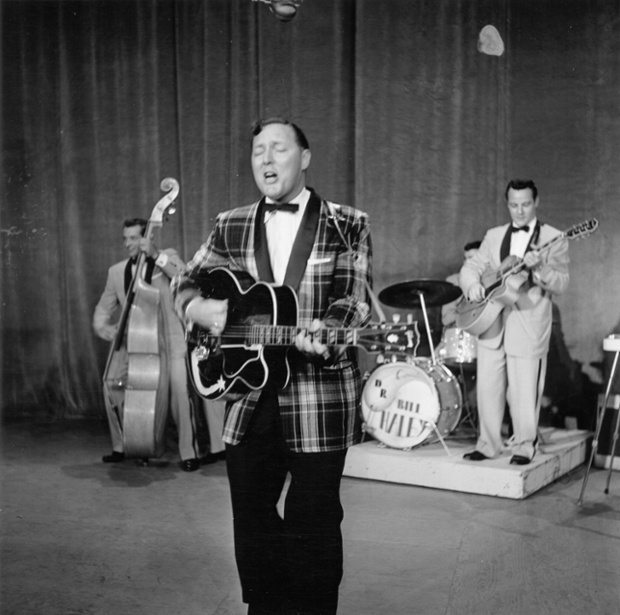
The clamour among young Russians for jazz and rock’n’roll during the cold war years is brought home by the range of materials on show at X-Ray Audio. Unofficial recordings weren’t pressed only on to x-rays – at the Horse Hospital, there are records made from road signs and circular cake plinths. Also working on X-Ray Audio with Coates is musician and sound-recording enthusiast Aleks Kolkowski, and on Friday the pair will present an evening of stories and demonstrations of the recording process in action, at which Kolkowski – the owner of a 1940s recording lathe – will record on to x-rays. “One thing this has shown me is that the format is completely integral to the listening experience,” explains Kolkowski, who also “repurposes” unwanted CDs by etching grooves into them, adjusting the hole in the middle and creating five-inch jukebox records. “CDs actually sound fantastic once you make them into actual records.”
There’s something oddly poignant about watching a record player stylus suck music – in this case, a doo wop song by the Ravens – out of the grooves of a CD. There’s some background noise, though nothing quite like the extraneous noise that comes with bone music. Later that day, I speak with Greg Milner, whose 2009 book Perfecting Noise Forever remains the definitive book on the history of recorded music. “We need to get out of that mindset that background noise happens at the expense of clarity. In the course of my research I listened to cylinders of performances that date back over 100 years ago. It’s hard to explain it, but you registered an acute presence in those recordings that was undeniable.”
Kolkowski agrees. “Humans like to hear things that sound like recordings, but the imperfections – the hisses and crackles – make us listen a bit harder. Reaching for perfection is more rewarding to the ears, whereas modern digital recordings deliver perfection directly. Somehow, without the effort, some of the satisfaction is taken away.” Coates, who is now writing a book about bone music, echoes his point: “The last time I was in Moscow, we were interviewing a guy who used to buy these bone recordings. He placed something on the turntable and all you could hear was ‘Chhhhh’, but with a tiny little bit of music through it. And he was beaming, because obviously it was taking him back to the first time he heard it. At the time, they used to call it ‘listening through sound’.”
Over time, however, it isn’t so much the x-ray recordings as the culture around them that has fascinated Coates. “What really kept me coming back was these stories that highlighted the tension between what the state wanted people to hear and what people naturally gravitated to. When people write about the phenomenon, they tend to focus on rock’n’roll, but a lot of Russian music that people had grown up with was also banned. There’s a Ukrainian singer calledPyotr Leshchenko – a Russian emigre who specialised in South American tango and gypsy music. After the second world war, when his music was outlawed, people would have to tune in to stations like Radio Tehran to hear his songs. The authorities set themselves too huge a task ultimately. You had popular Russian tunes that were classified as criminal songs, but they weren’t really. They were just regarded as ‘low culture’.”
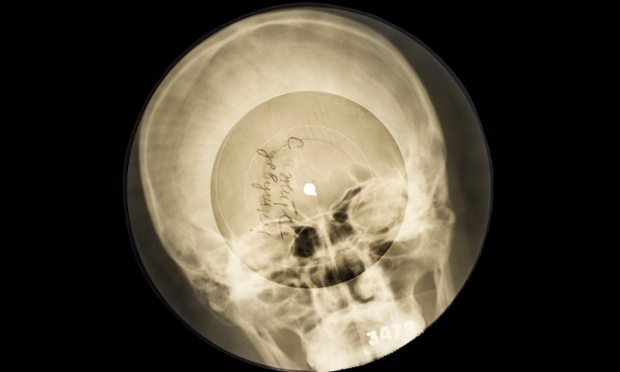
Coates ambles over to a display cabinet and pulls out another record, this time Guilty by the early 20th-century superstar Al Bowlly. Of all the bone recordings Coates has amassed, this one – given to him by Fuchs – is his favourite. “Rudy was suspicious around me at first, but when he found out that I was a fan of Al Bowlly, he finally opened up. His whole mission, if you like, was that from the moment he first heard this music, he wanted to share it. The problem was that the authorities knew this music was changing hands. They dispatched a young guy to Rudy, who befriended him and made an order for records. The next thing Rudy knew, his phone had stopped ringing. No one was calling him. Then he got arrested. The authorities tried to make him an informer, but he wouldn’t reveal any of his contacts. He went to prison for three years. On the day he was released, he carried on bootlegging. It wasn’t just his livelihood. He felt compelled to disseminate this music.”
In a era of unprecedented ubiquity for recorded music, it’s almost impossible to imagine that people could go to such lengths to hear a song. But this ubiquity didn’t happen overnight. It’s been happening by barely perceptible degrees over the past five decades. Even in this country, the small ads of music papers in the 1960s were frequently littered with desperate pleas from people who had heard a song once, sometimes years previously, and were haunted by the memory. “I’ll pay anything for the Hippies’ Memory Lane on Cameo Parkway,” reads one such classified, from a 1967 issue of Record Mirror, “I’ll even send a tape to someone to tape it for me.” As recently as the early 1980s in this country, we had Dial-A-Disc, a British Telecom service that people would phone in to hear a chart hit being played on the other end of the line.
For Coates, something has been lost in the Spotify era. “It’s important to remember what people will do to hear music when there’s hardly any of it around. “That doesn’t make X-Ray Audio an exhibition about something that happened 60 years ago. That also makes it an exhibition about what’s happening now.”
Thanks to the Guardian for this article
X-Ray Audio is at The Horse Hospital, London WC1N 1JD until Saturday, with a live recording tonight. horsehospital.com


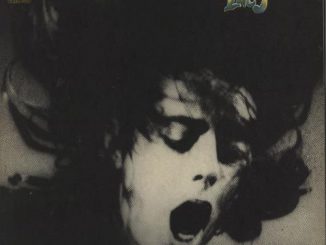
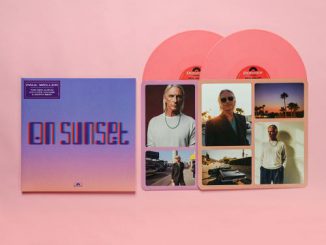
Be the first to comment